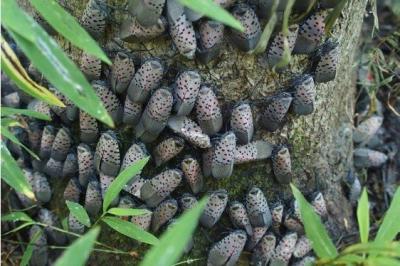Spotted Lanternfly Information
 The Spotted Lanternfly is an invasive planthopper native to China, India, Vietnam. It was first discovered in Pennsylvania in Berks County, and has spread to Lancaster County and other counties in the southeast portion of the Commonwealth. This insect has the potential to greatly impact agricultural crops such as grapes, hops, and hardwoods. It is also reducing the quality of life for people living in heavily infested areas.
The Spotted Lanternfly is an invasive planthopper native to China, India, Vietnam. It was first discovered in Pennsylvania in Berks County, and has spread to Lancaster County and other counties in the southeast portion of the Commonwealth. This insect has the potential to greatly impact agricultural crops such as grapes, hops, and hardwoods. It is also reducing the quality of life for people living in heavily infested areas.
What Is Being Done
Penn State University and Extension, U.S. Department of Agriculture (USDA), and PA Department of Agriculture (PDA) have joined forces to control and contain the spread of SLF. Penn State University is leading the research efforts currently underway to answer the many questions we have about the insect’s biology, pesticide studies, and the ability of the insect to adapt to the environment in Pennsylvania.
What Can Be Done
Spotted Lanternfly can be controlled with a combination of physical removal of life stages and host trees, as well as pesticide applications.
Businesses also play an important role. Business owners should incorporate pest management into their vegetation management plans and work to minimize the possibility of this insect hitching a ride on products they produce and ship. Businesses who ship products within and out of the quarantine zone are required to have or hire companies who have a Spotted Lanternfly Permit.
How You Can Help
This insect is easily moved if no one is looking. It is important to inspect your vehicles, trailers, or any outdoor items before you move around or out of the quarantine area. If possible, don’t park in tree lines and keep windows rolled up when you park your vehicle. Know the life stages of the insect and when to look for them. Any efforts you make in destroying the Spotted Lanternfly or it’s egg masses helps your property and community.
Please join the effort to control and prevent the spread of Spotted Lanternfly. We need everyone to protect their properties, communities, and the Commonwealth from this invasive insect that has the potential to change our landscape and quality of life.
Below are informational resources for this invasive species:

